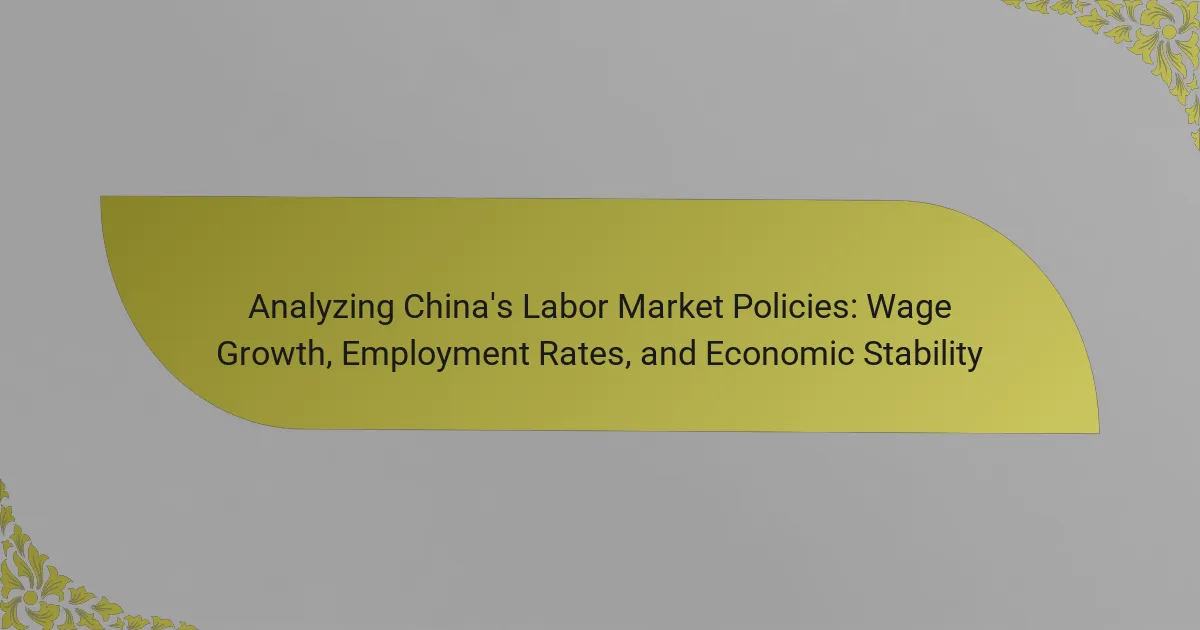China’s tax policies have undergone significant changes since the late 1970s, shifting from a centrally planned economy to a more market-oriented system. The Corporate Income Tax Law, established in 2008, standardized the corporate tax rate at 25%, with reduced rates of 15% for high-tech enterprises. Tax incentives are implemented to attract foreign investment, particularly in sectors like technology and renewable energy. However, businesses face compliance challenges due to complex regulations and frequent policy changes, necessitating ongoing adjustments to their strategies. The evolution of these tax policies reflects China’s response to economic conditions and aims to balance revenue generation with stimulating economic growth.

What are the key features of China’s tax policies over time?
China’s tax policies have evolved significantly over time. Key features include gradual reforms initiated in the late 1970s. These reforms shifted from a centrally planned economy to a more market-oriented approach. The introduction of the Corporate Income Tax Law in 2008 standardized tax rates at 25%. Special rates apply to high-tech enterprises, offering reductions to 15%. Additionally, China’s tax policies emphasize foreign investment through tax incentives. Compliance challenges have emerged due to complex regulations and frequent changes. The government has implemented measures to enhance tax administration and compliance. Overall, China’s tax policies reflect a balance between revenue generation and economic growth stimulation.
How have corporate tax rates evolved in China?
Corporate tax rates in China have undergone significant changes since the early 2000s. In 2008, the corporate income tax rate was unified at 25% for most enterprises. Before this, foreign-invested enterprises enjoyed a preferential rate of 15% or 24%. The transition aimed to simplify the tax system and promote fairness. In recent years, the government has introduced incentives for specific industries. For instance, high-tech enterprises can benefit from a reduced rate of 15%. Additionally, small and low-profit enterprises may qualify for further reductions. These adjustments reflect China’s strategy to attract investment and stimulate economic growth. Overall, corporate tax rates have evolved from a fragmented system to a more standardized approach with targeted incentives.
What historical factors influenced changes in corporate tax rates?
Historical factors that influenced changes in corporate tax rates include economic reforms, globalization, and government fiscal policies. In China, the economic reforms initiated in 1978 shifted the focus towards a market-oriented economy. These reforms led to the introduction of tax incentives to attract foreign investment. Globalization further pressured China to align its corporate tax rates with international standards. Additionally, government fiscal policies aimed at stimulating economic growth often prompted adjustments in tax rates. For instance, the Corporate Income Tax Law of 2008 unified tax rates for domestic and foreign enterprises, reflecting a strategic shift in tax policy. These historical influences collectively shaped the evolution of corporate tax rates in China.
How do current corporate tax rates compare to previous rates?
Current corporate tax rates in China are lower than previous rates. The standard corporate tax rate was reduced from 33% to 25% in 2008. This reduction aimed to attract foreign investment and stimulate economic growth. Additionally, certain sectors may benefit from even lower rates, such as high-tech industries. Over the years, China has also implemented various tax incentives to encourage specific business activities. These changes reflect a shift in tax policy to enhance competitiveness. Overall, the current corporate tax environment is more favorable compared to past rates.
What incentives exist within China’s tax policies for corporations?
China’s tax policies offer several incentives for corporations. These incentives include reduced corporate income tax rates for specific industries. High-tech enterprises can benefit from a 15% tax rate instead of the standard 25%. Additionally, companies investing in certain regions may receive tax holidays. Small enterprises also enjoy lower tax rates, often at 20%. Furthermore, research and development expenditures can be deducted, providing further tax relief. These policies aim to stimulate economic growth and attract foreign investment. The effectiveness of these incentives is reflected in the increase of foreign direct investment in China.
What types of tax incentives are offered to businesses in China?
China offers several types of tax incentives to businesses. These incentives include reduced corporate income tax rates for certain industries. High-tech enterprises may enjoy a 15% tax rate, lower than the standard 25%. Additionally, businesses in special economic zones receive preferential tax treatment. Research and development activities can qualify for tax deductions. Small enterprises may benefit from lower tax rates based on their income levels. Export-oriented businesses also receive various tax exemptions. These incentives aim to attract foreign investment and stimulate economic growth.
How effective are these incentives in attracting foreign investment?
These incentives are highly effective in attracting foreign investment. China’s tax incentives, such as reduced corporate tax rates and preferential treatment for specific sectors, significantly enhance the investment landscape. For instance, the corporate tax rate for foreign enterprises can be as low as 15% in designated areas. According to the Ministry of Commerce, foreign direct investment (FDI) in China reached $163 billion in 2020, largely due to these favorable policies. Additionally, regions like the Guangdong Free Trade Zone have reported a 30% increase in foreign investment since implementing tax incentives. These statistics demonstrate the direct correlation between tax incentives and foreign investment attraction.
What compliance challenges do corporations face in China?
Corporations face significant compliance challenges in China due to complex regulations. The regulatory environment is constantly evolving, making it difficult for companies to stay updated. Different regions in China may have varying compliance requirements. Understanding local tax laws and incentives can be a daunting task. Language barriers further complicate communication with regulatory authorities. Additionally, the risk of penalties for non-compliance is high. Companies must also navigate issues related to data security and privacy laws. The lack of clear guidance on compliance processes adds to the uncertainty for corporations operating in China.
What are the common compliance issues reported by businesses?
Common compliance issues reported by businesses include inadequate record-keeping, failure to meet filing deadlines, and misunderstanding tax regulations. Inadequate record-keeping leads to challenges in substantiating claims during audits. Failure to meet filing deadlines can result in penalties and interest charges. Misunderstanding tax regulations often arises from frequent changes in policies and requirements. Research indicates that 60% of businesses struggle with compliance due to these factors. Additionally, the complexity of tax codes can exacerbate these issues, making it difficult for companies to remain compliant.
How do regulatory changes impact compliance for corporations?
Regulatory changes significantly impact compliance for corporations by altering the legal framework they must adhere to. These changes can introduce new requirements for reporting, record-keeping, and operational practices. For instance, when China revised its tax policies, corporations faced new compliance obligations that required adjustments in their accounting systems. Non-compliance can lead to penalties, fines, or legal repercussions, which incentivizes corporations to stay updated. Additionally, regulatory changes often necessitate employee training and awareness programs to ensure adherence. This can strain resources, particularly for smaller companies. Overall, corporations must continuously monitor regulatory developments to maintain compliance and avoid risks associated with non-compliance.

What role do economic conditions play in shaping tax policies?
Economic conditions significantly influence tax policies. Governments adjust tax rates and structures based on economic performance. During economic growth, higher tax revenues may lead to reduced rates or increased spending. Conversely, in a recession, governments often raise taxes to maintain revenue. Economic conditions also affect public sentiment towards taxation. For instance, high unemployment may lead to demands for tax relief. Historical data shows that tax reforms often align with economic cycles. In China, recent tax policies have adapted to shifting economic landscapes. These adjustments aim to stimulate growth and enhance compliance.
How do economic growth rates influence tax policy adjustments?
Economic growth rates significantly influence tax policy adjustments. When economic growth is strong, governments may increase tax revenues through higher income and consumption levels. This additional revenue can lead to tax cuts or increased public spending. Conversely, during periods of slow growth, governments might raise taxes to maintain fiscal stability. For example, China’s economic growth rate has fluctuated, prompting adjustments in corporate tax rates and incentives. In 2020, amidst a slowdown, China focused on tax relief measures to stimulate growth. This pattern illustrates how economic conditions directly shape tax policy decisions.
What specific economic indicators are linked to tax policy changes?
Tax policy changes are linked to specific economic indicators such as GDP growth, inflation rates, employment rates, and government revenue. GDP growth reflects the overall economic performance and can influence tax policy adjustments. Inflation rates affect purchasing power and can prompt changes in tax brackets or rates. Employment rates indicate labor market health and can lead to tax incentives aimed at job creation. Government revenue is directly impacted by tax policy, influencing budgetary decisions and fiscal policy. Historical data from various economies show that tax reforms often correlate with shifts in these indicators, demonstrating their interconnectedness.
Why is understanding tax policy evolution important for businesses?
Understanding tax policy evolution is crucial for businesses as it directly impacts financial planning and compliance. Changes in tax laws can affect corporate tax rates, incentives, and overall operational costs. For instance, a shift in tax policy may lead to increased tax liabilities or new opportunities for tax incentives. Firms that adapt to these changes can optimize their tax strategies. Historical data shows that companies that proactively monitor tax policy changes can reduce their tax burden by up to 30%. Additionally, understanding these policies helps businesses avoid compliance issues that could result in penalties. Thus, keeping abreast of tax policy evolution is essential for maintaining financial health and competitive advantage.
How can businesses prepare for future changes in tax legislation?
Businesses can prepare for future changes in tax legislation by staying informed about potential reforms. They should regularly review tax regulations and proposed changes from government sources. Engaging with tax professionals can provide insights into upcoming legislation. Additionally, businesses should assess their current tax strategies for adaptability. Implementing flexible financial planning is crucial for accommodating future shifts. Furthermore, participating in industry associations can help businesses share knowledge and strategies. Keeping open communication with stakeholders will ensure readiness for changes. Monitoring economic trends can also provide context for potential legislative developments.

What are the implications of China’s tax policies on global business strategies?
China’s tax policies significantly influence global business strategies. The corporate tax rate in China is currently set at 25%, which affects profit margins for foreign companies. Additionally, tax incentives are offered in specific sectors, encouraging foreign investment in technology and renewable energy. Compliance challenges arise due to the complexity of China’s tax regulations. Companies must adapt their strategies to navigate these regulations effectively. Failure to comply can result in heavy penalties, impacting business operations. Furthermore, changes in tax policies can lead to shifts in market entry strategies for multinational corporations. Overall, businesses must continuously monitor and adjust their strategies in response to China’s evolving tax landscape.
How do China’s tax policies affect multinational corporations?
China’s tax policies significantly impact multinational corporations by influencing their operational costs and investment strategies. The corporate tax rate in China is generally set at 25%. However, certain sectors and regions may benefit from reduced rates or tax incentives. For instance, high-tech enterprises can enjoy a reduced rate of 15%. Multinational corporations often adjust their financial planning based on these rates. Compliance with tax regulations can also pose challenges, leading to increased administrative costs. Additionally, changes in tax policies can affect the competitiveness of foreign firms in the Chinese market. Thus, these policies play a crucial role in shaping business decisions for multinational corporations operating in China.
What strategies can companies adopt to navigate China’s tax landscape?
Companies can adopt several strategies to navigate China’s tax landscape effectively. First, they should stay informed about the latest tax regulations and policies. The Chinese tax system is complex and frequently changes. Engaging local tax experts can provide insights into compliance requirements. Additionally, companies can leverage tax incentives offered by the government. These incentives may include reduced rates for specific industries or regions. Establishing a robust tax compliance framework is crucial. This ensures timely filing and payment of taxes, reducing the risk of penalties. Furthermore, companies can consider restructuring their operations. This may involve setting up subsidiaries in favorable tax jurisdictions. Regular audits of tax practices can identify potential risks and areas for improvement. These strategies collectively enhance a company’s ability to navigate the intricacies of China’s tax environment.
What best practices should companies follow for tax compliance in China?
Companies should follow several best practices for tax compliance in China. First, they must stay updated on local tax laws and regulations. China frequently updates its tax policies, so ongoing education is crucial. Second, companies should maintain accurate and detailed financial records. This ensures transparency and simplifies the audit process. Third, engaging a local tax advisor is beneficial. Local experts understand the nuances of the Chinese tax system. Fourth, companies should implement robust internal controls. This minimizes the risk of errors and fraud. Fifth, timely filing of tax returns is essential. Late submissions can lead to penalties. Lastly, companies should regularly review their tax strategies. This helps in optimizing tax liabilities and ensuring compliance. Following these practices can significantly reduce the risk of tax-related issues in China.
How can businesses stay updated on tax policy changes?
Businesses can stay updated on tax policy changes by regularly consulting government websites. These websites often publish the latest tax regulations and updates. Subscribing to newsletters from tax authorities can also provide timely information. Engaging with professional tax advisors ensures businesses receive expert insights. Attending industry conferences and seminars can highlight recent changes and trends. Utilizing tax software often includes updates on regulatory changes. Following reputable financial news sources can keep businesses informed about broader tax policy discussions. Networking with other businesses can facilitate the sharing of relevant information on tax matters.
What resources are available for corporations to ensure compliance?
Corporations can utilize various resources to ensure compliance with tax policies. These resources include legal counsel specializing in tax law. They provide guidance on regulatory requirements and changes. Compliance software is also available to help manage tax obligations efficiently. This software automates calculations and reporting processes. Additionally, training programs for employees ensure they understand compliance requirements. Industry associations often provide resources and updates on best practices. Governments may offer official guidelines and support for compliance. These resources collectively help corporations navigate complex tax regulations effectively.
The primary entity of this article is China’s tax policies, specifically focusing on corporate tax rates, incentives, and compliance challenges. The article outlines the evolution of these tax policies since the late 1970s, highlighting key reforms such as the unification of corporate tax rates at 25% in 2008 and the introduction of incentives for high-tech enterprises. It discusses the impact of historical factors and economic conditions on tax policy changes, as well as the compliance challenges faced by corporations due to complex regulations. Additionally, the effectiveness of tax incentives in attracting foreign investment and the strategies companies can adopt to navigate the tax landscape are examined.



